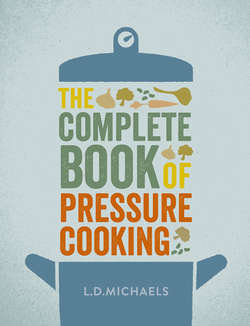Читать книгу The Complete Book of Pressure Cooking - L.D. Michaels - Страница 13
Disadvantages
ОглавлениеBut there are also a number of downsides – and not all of them are immediately obvious.
The first is slow depressurizing. At the end of cooking time, the inside of the pressure cooker has to return to normal atmospheric pressure and the temperature must drop. Most pressure cookers have a safety device stopping you from premature opening before pressure has been reduced. With a stove-top pressure cooker, you can reduce temperature by taking the cooker off the heat and placing it under cold running water – the so-called rapid cooling method. You can’t do this with an electric cooker; indeed, because many electric pressure cookers have insulated walls in order to keep the food warm and minimize fuel costs, it can take rather a long time after cooking has finished before you can open the cooker to get at the food.
The next downside is that most electric pressure cookers operate at lower pressures than their stove-top siblings – 12 psi is usually the highest you will find (compared with 15 psi for many stove-top cookers) and some are as low as 7 psi. As a result, cooking times are longer.
Then there is the problem of searing. As we will see later, one of the basic techniques of pressure-cooking meats involves searing or briefly frying at high temperature the outside of the piece of meat or chicken. Searing is important both to taste and appearance. In a stove-top cooker you can carry out the searing in the pan itself, pouring out any excess fat or oil when you have achieved sufficient browning. Some electric pressure cookers have a searing feature, but getting rid of the excess fat is still a necessary separate stage if you are to avoid the resulting dish being too greasy.
Three other things to think about: electric pressure cookers are inevitably more complex than stove-top models so that you must anticipate a shorter life. Related to that, the issue of the availability and cost of spares, important enough with stove-top models, is much more important for electric models. Finally, it is quite easy to buy via internet mail order electric pressure cookers that may not readily work on the electricity supply you have in your home. Models sold for the North American market are designed for 110–115 volt supplies, whereas in most of the rest of the world 220–240 volts is the norm. I have not yet come across dual-voltage models. Electric pressure cookers tend to draw a lot of current, which means that, if a step-up-step-down transformer is used, it needs to be very substantial and often the cost of the transformer will exceed the cost of the pressure cooker!
